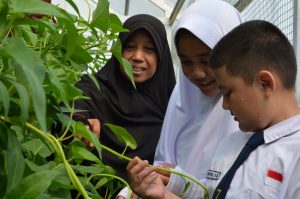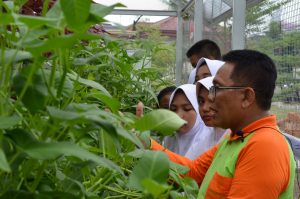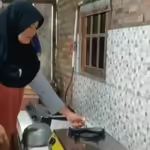Teachers of 213 State Junior High School of East Jakarta took a different approach to teach their students about natural sciences. The greening initiative quickly shift to learning how to grow their own food and better understanding of how and where food comes from.
Duren Sawit, East Jakarta. When appointed as the headmaster, Waryanto made it his mission to greening arrid lands of 213 State Junior High School (SMPN 213) of East Jakarta and turning the school into one of the examplery practices in hydroponic farming.
Within a year, the four-story school building occupies half of the 6,900 square meters, meanwhile, the remaining half had transformed into a green zone.
“I prioritize on environmental [behavior] change,” said Waryanto, who goes by one name. “If students and teachers are comfortable, then studying will be fun.”
Initially, Waryanto, along with students and teachers, had planted 75 Madagascar Almond (Terminalia Mantaly) and developed an orchid garden on the dry lands.
He became interested in hydroponic farming after being introduced the technique by an educational institution, initiated by Javanese Christian Church community in East Jakarta called Omah Tani or House of Farmers.
He took the idea to other teachers and school committee, highlighting the two things that hydroponic farming can help achieve, — greening the school areas and supporting Natural Sciences curriculum –.
“Students can learn many things outdoor, not just inside of the class,” he said. “In addition, this is also an effort to support government’s program for greening.”
Today, SMPN 213’s hydropnic farm is dubbed as one of the largest in the DKI Jakarta province.
Mud-Free Farming
Students, in general, describe farming — which they learn through media or visit to villages — with images of farmer carrying a hoe working in large paddy fields and covered with dirty mud.
But that image had shifted for students of SMPN 213 as they learned more about hydroponic farming with Omah Tani’s in November 2017. For them, farming can be easy and fun.
”We brought [hydroponic farming] to schools as we consider it important and part of the environmental education in 2013 curricullum,“ said Haryanto, one of the founders of Omah Tani. “We showed [the students] that plants can grow without pesticide, easy and not dirty.“
At least 75 students of Grade 7 and teachers participated in the training.
Students and teachers then initiated the construction of the 3×10 meter greenhouse, formerly used as orchid garden, and installed four levels of eight meter long pipes forming the A-shape compartment. The pipes have a total of 180 growing chambers.
For the first experiment, students were given bok choy seeds and rockwool, a growing medium, to plant the seeds in their homes. Along with the starter kit, the responsibility to monitor the plants development, monitor for pests, and ensure enough sunlight and nutrition.
After leaves started to grow, students brought them to the garden to be transfered into the growing chambers.
“What we teach here is about responsibility,” said Martis, the natural sciences teacher in the school.

Within a month, students harvested their own bok choy.
“On December 2017, we harvested our first bok choy,” she said adding that the harvests were sold to parents and guests without any price tags and collected Rp800 thousands.
“The money will be used to purchase more seeds, rockwools, and nutrition for next planting season,” she said who is also responsible for hydroponic farming in the school.
After the success of first harvest, students started to plant lettuce, water spinach, spinach mustard, red spinach, to broccoli.
“Many children in Jakarta do not know the origin of vegetables that they’re eating. Their food have always been made available and bought from the supermarket,“ said Waryanto. “We are trying to plant vegetables that children consume on daily basis.“
Martis notes that she had seen direct changes towards the environment from her students as they got involved with hydroponic farming in the school.
“From being indifferent towards the environment, they now have respect [for the environment],” she said.
In addition, students appear to have different understanding and appreciation about the work in agriculture.
Previously, they consider farmers identical with hoe, mud and vast lands. “But, when they were introduced to modern way of farming through hydroponic, their way of thinking has changed,” she said.
For Tasya, one of the 7th Grader, planting and harvesting have had quite an impression.
“It turns out planting vegetables is not difficult, [I] don’t need land, no fertilizer,” she said.
Muhammad Roji, head of Regional 1 Education Agency, East Jakarta, who was attending the first harvest challenged the school to plant paddy using small pots in the areas.
A challenge accepted by students and teachers, who collected used buckests as growing medium and purchased seeds from Karawang of West Java.
Introducing and rescaling a paddy field to students was a new experience for Martis as they know very little about how paddy is grown.
A student, even asked why are they planting grass, as paddys grew 15 centimeter tall.
“I was stunned [by the question] because my own student didn’t know [what] paddy [is]. I told the student that it is not grass [but] paddy. I asked [them] what did they eat at home and [the student] replied rice. I asked where did rice come from, they said rice [grain]… I asked again where does rice come from, and they answered paddy,” she said.
Nevertheless, the question had motivated Martis and Waryanto to plant more trees, including kedondong (Spondias dulcis), longan, rose apple, banana, decorative plants and medicines, and made use them as an effective learning platform for students.
The Future of Hydroponic Farming in Schools
Introducing farming to school students is an effort to foster interest in agriculture, at an early age.
Martis said that several students have shown interest in becoming vegetable entreprenuers.
“I always motivate [students] that hydroponic farming has many benefits, including form a business stand point,” she said claiming that SMPN 213 was the first to implement bussiness development for hydroponic farming on a junior high school level.
Though not specific, she cited other pilot schools, including a vocational high school in Semarang and a madrasa in Cianjur, which have been developing bussiness models for hydroponic farming.

But teachers have claimed that the SMPN 213’s hydroponic farm has become a pilot project for other schools in Jakarta greater areas.
Roji said that DKI Jakarta administration is ready to support hydroponic farming as it had been included in the school’s curriculum in 2013 and saw implementation in 2014.
“Hydroponic farming will be a good place to teach modern agriculture model to students,” said Roji.
Martis added that there have been other schools that came to SMPN 213 to watch and learn hydroponic farming to be applied in their own schools.
“There are always guests coming from other school, every month, and [they] want to learn more on how we develop hydroponic farming,” she added.
One of the visitors was Ermai Afriani, a natural sciences teacher of SMPN 198 of East Jakarta, who was interested to see the development of hydroponic farming in the school.
“I am very interested as hydroponic farming does not require vast areas and the crops are hygienic and not contaminated by chemical substance,” said Afriani in April.
Today, the hydroponic farm in SMPN 213 serves as a leraning tool, although, Waryanto, has bigger plans. The headmaster is actively looking out for entrepreneurial and bussiness opportunities as well as a market for their produce, including supplying for the school’s cooperative market or surrounding neighborhood.
“We have received requests [to supply crops from the farm], hopefully [we] can meet [that demand] one day,” said Waryanto.
- How is the development of the equitable energy transition program in Indonesia?
 JETP funds will target equitable energy transition projects in a number of developing countries, one of which is Indonesia.
JETP funds will target equitable energy transition projects in a number of developing countries, one of which is Indonesia. - Samirono village energy transformation, from waste to clean energy
 Samirono village has proven that innovation and collaboration can bring big changes. They showed the world that waste can be turned into clean energy.
Samirono village has proven that innovation and collaboration can bring big changes. They showed the world that waste can be turned into clean energy. - Alternative energy from Sumedang tofu waste, between innovation and sustainability
 Sumedang tofu is not only savory and delicious, but there is a waste problem that pollutes the environment. In Giriharja Village, tofu waste is processed into alternative energy.
Sumedang tofu is not only savory and delicious, but there is a waste problem that pollutes the environment. In Giriharja Village, tofu waste is processed into alternative energy. - BPA labeling protects consumers, not business competition
 BPKN believes the mandatory BPA labeling policy for polycarbonate gallon packaging is not about business competition. The policy, outlined in Food and Drug Monitoring Agency (BPOM) Regulation Number 6 of 2024
BPKN believes the mandatory BPA labeling policy for polycarbonate gallon packaging is not about business competition. The policy, outlined in Food and Drug Monitoring Agency (BPOM) Regulation Number 6 of 2024 - Learning from Orangutan Wisdom in the Wehea-Kelay Landscape, East Kalimantan
 Research identified 59 orangutan food plants, with over 50% having medicinal properties
Research identified 59 orangutan food plants, with over 50% having medicinal properties - Indonesia’s Green Energy Transition: JETP Secures $1 Billion for Electrification Projects
 Indonesia’s JETP Progress: $21.6 Billion Green Energy Investment Plan Targets Renewable Power and Job Creation
Indonesia’s JETP Progress: $21.6 Billion Green Energy Investment Plan Targets Renewable Power and Job Creation








